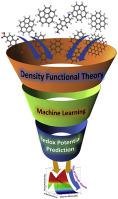Materials Today Energy ( IF 9.0 ) Pub Date : 2020-07-15 , DOI: 10.1016/j.mtener.2020.100482 O. Allam , R. Kuramshin , Z. Stoichev , B.W. Cho , S.W. Lee , S.S. Jang

|
In this study we develop a high-throughput screening method by employing a density functional theory (DFT) - machine learning (ML) framework for the design of novel organic electrode materials. For this purpose, DFT modeling is performed to calculate basic electronic properties of various organic compounds, namely redox potential, electron affinity, highest occupied molecular orbital (HOMO) and lowest unoccupied molecular orbital (LUMO), which are used in conjunction with basic molecular descriptors to train three machine learning models (ML): artificial neural networks (ANN), gradient-boosting regression (GBR), and kernel ridge regression (KRR) through three different protocols. These three protocols, or pipelines, are developed in order to enhance each model's capability to learn the data and make predictions. The first two pipelines utilize the original features only, while the third pipeline utilizes composite features which are screened by a least absolute shrinkage and selection operator (LASSO). Particularly, the second and third pipelines employ a Pearson correlation analysis in conjunction with recursive feature elimination (RFE). From this study, the most important features to predict redox potential are identified as the electron affinity and the number of bound Li atoms. After optimizing machine learning models in each pipeline, it is found that KRR predicts the redox potential with the highest accuracy.
中文翻译:

分子结构-有机电极材料的氧化还原电位关系:密度泛函理论-机器学习方法
在这项研究中,我们通过采用密度泛函理论(DFT)-机器学习(ML)框架设计新型有机电极材料,开发了一种高通量筛选方法。为此,执行DFT建模以计算各种有机化合物的基本电子性质,即氧化还原电势,电子亲和力,最高占据分子轨道(HOMO)和最低未占据分子轨道(LUMO),并与基本分子描述符结合使用通过三种不同的协议来训练三种机器学习模型(ML):人工神经网络(ANN),梯度提升回归(GBR)和内核岭回归(KRR)。这三个协议或管道,为了增强每个模型学习数据和进行预测的能力而开发的工具。前两个流水线仅利用原始特征,而第三个流水线利用由最小绝对收缩和选择算子(LASSO)筛选的复合特征。特别是,第二条和第三条管线结合了递归特征消除(RFE)进行了Pearson相关分析。根据这项研究,预测氧化还原电势的最重要特征是电子亲和力和结合的Li原子数。在优化了每个管道中的机器学习模型之后,发现KRR以最高的准确性预测了氧化还原潜力。











































 京公网安备 11010802027423号
京公网安备 11010802027423号